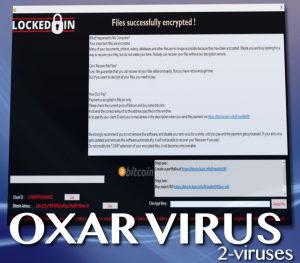OXAR ransomware virus is a fresh variant that got detected on the 10th of July. Soon enough, the detected sample with the payload of Data Locker.exe was established to fit in one specific family of crypto-viruses. The sample’s structure was consistent with the open source Hidden Tear project. These variants are not significantly-threatening, but their AES encryption can encode victims’ files and ask for a ransom in exchange of a decryption key. This password is stored in private servers of the authors of OXAR crypto-virus.
Nevertheless, there is no necessity to abide by the rules that the hackers have enumerated in the screen-locker. Every user or so-called ‘client’ receives a special ID number. In the screen-locker that reduces the number of ways you can interact with your device, a ransom of 100 US dollars or 0.04369 BTC is established. Do not waste money and continue on reading this article to restore files that feature .OXR extension.

The infection contains some features that help it remain undetected by anti-virus applications. One of the evasive techniques is to make the payload enable sleep mode for several minutes. It also plans other modifications like changes in Registry to make the payload auto-execute. For the process of file-encoding, the ransomware targets executables of over 70 types. Once their content is no longer recognizable by the user, the filename will be remodeled to foster a new extension, which will be the .OXR.
How to start the decryption process free-of-charge?
As we have mentioned, there is no reason to pay the ransom as there is a way to recover files without hurting you financially. It appears that this sample was not difficult to crack and security researchers have already accomplished the necessary examination to find errors in the harmful software. Unexpectedly, they stumbled upon a discovery that will make the OXAR ransomware no longer a legit threat.
In the displayed screen-locker that prevents you from comfortably utilizing your operating system, you should find the section that requires the “Decrypt Key” to be entered. Much to our surprise, it is enough to type “key” and press the button of “Decrypt File”. The file-recovery process should begin automatically.
How to evade crypto-viruses?
Uploading your digital data in backup storages or selecting another alternative location is crucial. Store at least those executables that you would pay money to get back if they became unavailable. This will save you from having to suffer the consequences of a crypto-virus. Not in all ransomware-cases can a free-file recovery be a possibility. Since this type of infections are aiming for new heights and becoming more and more sophisticated, we would make the process of file-back upping a priority for all.
Ransomware infections are distributed in highly-deceptive methods. By visiting a random domain, you might allow a drive-by download to occurs and to insert a malicious payload into your operating system. Campaigns of misleading and seemingly-urgent emails is also a possibility. Hackers could add malicious executables as attachments that will be involved in the plans of file-encoding.
Since a ransomware managed to invade your operating system, it is clear that your device has become vulnerable to such attacks and you should consider possible methods of restoring order in your operating system. We recommend that you can your device with an appropriate security tool. It will help you find out sources for the ransomware infection. Since your security-shields no longer serve you justly, more malware samples could be residing into your operating system and complicating the situation even further. Exploit the possibilities of Spyhunter or Malwarebytes and your security and privacy will receive the long awaited assistance.
Oxar Ransomware Virus quicklinks
- How to start the decryption process free-of-charge?
- How to evade crypto-viruses?
- Automatic Malware removal tools
- How to recover OXAR ransomware virus encrypted files and remove the virus
- Step 1. Restore system into last known good state using system restore
- 1. Reboot your computer to Safe Mode with Command Prompt:
- 2.Restore System files and settings.
- Step 4. Use Data Recovery programs to recover OXAR ransomware virus encrypted files

Automatic Malware removal tools
(Win)
Note: Spyhunter trial provides detection of parasites and assists in their removal for free. limited trial available, Terms of use, Privacy Policy, Uninstall Instructions,
(Mac)
Note: Combo Cleaner trial provides detection of parasites and assists in their removal for free. limited trial available, Terms of use, Privacy Policy, Uninstall Instructions, Refund Policy ,
How to recover OXAR ransomware virus encrypted files and remove the virus
Step 1. Restore system into last known good state using system restore
1. Reboot your computer to Safe Mode with Command Prompt:
for Windows 7 / Vista/ XP
- Start → Shutdown → Restart → OK.
- Press F8 key repeatedly until Advanced Boot Options window appears.
- Choose Safe Mode with Command Prompt.

for Windows 8 / 10
- Press Power at Windows login screen. Then press and hold Shift key and click Restart.

- Choose Troubleshoot → Advanced Options → Startup Settings and click Restart.
- When it loads, select Enable Safe Mode with Command Prompt from the list of Startup Settings.

2.Restore System files and settings.
- When Command Prompt mode loads, enter cd restore and press Enter.
- Then enter rstrui.exe and press Enter again.

- Click “Next” in the windows that appeared.

- Select one of the Restore Points that are available before OXAR ransomware virus has infiltrated to your system and then click “Next”.

- To start System restore click “Yes”.

Step 2. Complete removal of OXAR ransomware virus
After restoring your system, it is recommended to scan your computer with an anti-malware program, like Spyhunter and remove all malicious files related to OXAR ransomware virus. You can check other tools here.Step 3. Restore OXAR ransomware virus affected files using Shadow Volume Copies
If you do not use System Restore option on your operating system, there is a chance to use shadow copy snapshots. They store copies of your files that point of time when the system restore snapshot was created. Usually OXAR ransomware virus tries to delete all possible Shadow Volume Copies, so this methods may not work on all computers. However, it may fail to do so. Shadow Volume Copies are only available with Windows XP Service Pack 2, Windows Vista, Windows 7, and Windows 8. There are two ways to retrieve your files via Shadow Volume Copy. You can do it using native Windows Previous Versions or via Shadow Explorer. a) Native Windows Previous Versions Right-click on an encrypted file and select Properties → Previous versions tab. Now you will see all available copies of that particular file and the time when it was stored in a Shadow Volume Copy. Choose the version of the file you want to retrieve and click Copy if you want to save it to some directory of your own, or Restore if you want to replace existing, encrypted file. If you want to see the content of file first, just click Open.
b) Shadow Explorer It is a program that can be found online for free. You can download either a full or a portable version of Shadow Explorer. Open the program. On the left top corner select the drive where the file you are looking for is a stored. You will see all folders on that drive. To retrieve a whole folder, right-click on it and select “Export”. Then choose where you want it to be stored.

Step 4. Use Data Recovery programs to recover OXAR ransomware virus encrypted files
There are several data recovery programs that might recover encrypted files as well. This does not work in all cases but you can try this:- We suggest using another PC and connect the infected hard drive as slave. It is still possible to do this on infected PC though.
- Download a data recovery program.
- Install and scan for recently deleted files.








